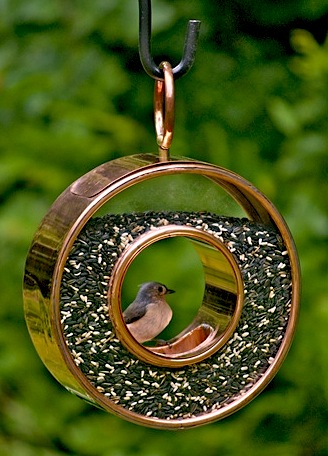-
black hulls from your nyjer feeder
 A friend of mine who’s new to birding recently received a nyjer feeder as a gift. Several times I’d asked if the finches were coming, but the answer was always no. Difficult for me to understand as our yard just forty miles away was inundated with Goldfinches.
A friend of mine who’s new to birding recently received a nyjer feeder as a gift. Several times I’d asked if the finches were coming, but the answer was always no. Difficult for me to understand as our yard just forty miles away was inundated with Goldfinches.The other day I asked again if there were any Goldfinches in the yard. This time my friend said no, none to be seen, but the seed was all over the ground. It only took a second to realize they were at the nyjer feeder if it was being emptied!
Thistle (or nyjer) is a non-germinating seed. It’s tiny grain-like shape is actually comprised of two parts: the seed itself, and the hull containing the seed. Goldfinches and others, will discard the hulls when feeding at nyjer feeders. These tiny black hulls tend to accumulate under the feeder as no other wildlife finds them suitable to the palette. For bird’s health, and aesthetics, it’s best to scoop up the hulls periodically as they become moldy and create a messy feeding area where fungus and bacteria could be easily spread.
So when my friend said “the seed’s all over the ground”… I knew right away the Goldfinches had discovered the new feeder. Maybe they just need to hone in on the bird watching skills?
-
Molting, migration and wild bird feeders
An interesting and well-written post in the Bluebird Monitors Forum.
Used with permission: by Keith Kridler, Mount Pleasant, TexasMolting and migration already underway in EXTREME drought:
Watch around your homes and yards and find this past breeding year plumage laying around observe how worn off the ends of the primary flight feathers and tail feathers are. Look to see how the color has been shed or worn off from these feathers. Or how these feathers now have lost the top layer of cells and do not “reflect” their true colors.
Feathers are REALLY high in protein, as birds are molting they require a diet higher in protein than they normally do.Flocks of grackles are arriving already. Hummingbirds are really beginning to flock to feeders. Only about half as many this year as in the past years possibly due to the severe drought this summer. In 2008 we had already fed over 50 pounds of sugar. This year we have only fed 20 pounds.
We are seeing small flocks of male Indigo Buntings everyday. Titmice and White Breasted Nuthatches are really busy as they empty the sunflower wild bird feeders and are stuffing extra seeds into holes and crevasses in bark. Scissor tailed flycatchers are moving through as are lots of other flycatchers. Inca and Mourning Doves as Bob mentioned are in very high numbers. Turkey and Quail breeding success was dismal across Texas this year.
Skunks, coons, possums and other four legged predators are moving to towns or raiding pet food and water dishes at rural homes. Wild Hogs are moving during the day and are actually breaking into bales of hay and eating grass as the soils are too hard to dig up roots. Hog scat is filled with bits and pieces of grasshoppers right now! Picture herds of 20 or more hogs out in pastures chasing large grasshoppers for a meal!
Small ponds in Texas are drying up or becoming toxic with stagnant water and or algae blooms. Small streams are powder dry. The Sabine River is dry almost 300 miles BEFORE it gets to the Gulf of Mexico. The Martin Lake coal fired power plant is running low on cooling water. Their average lake water temperature is now over 114*F or just about to the point where they are cooking fish and turtles.
Brutal heat continues locally with temperatures yesterday at 5 PM still at 106*F. The human population of Texas has tripled during HALF of a humans average lifespan. We moved past 25 million Texans now and are consuming 60,000 megawatts of electricity day after day during this heat.
Dry land farming has corn harvests in the state from 7 to 25 bushels of corn per acre….These should be from 100 to 125 in a normal rainfall year in this state or less than half of production from states in the “corn belt”.
-
A very Cool Copper & glass bird feeder
 With daylight hours starting to wane, the activity around backyard bird feeders is actually gearing up. Hummingbirds especially are frenzied around feeders, preparing for their migration south.Be sure to keep your feeders fresh and full until freezing becomes a problem.
With daylight hours starting to wane, the activity around backyard bird feeders is actually gearing up. Hummingbirds especially are frenzied around feeders, preparing for their migration south.Be sure to keep your feeders fresh and full until freezing becomes a problem.Seed feeders too are being emptied at quicker rate. This cool glass bird feeder holds five pounds of seed, but it’s being filled every 3 or 4 days at our place. And it’s not the only one! Our North Georgia yard hosts about 20 different kinds of bird feeders!
It’s wonderful to watch, when the time is actually taken to sit on the deck with a cup of coffee and just watch. Some friends visited last week and said: “it looks like Hartsfield Airport at rush hour back here”. Honestly… at times it really does!
